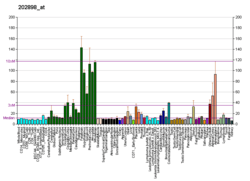Syndecan-3
Syndecan-3 is a protein that in humans is encoded by the SDC3 gene.[5][6][7]
References
- 1 2 3 GRCh38: Ensembl release 89: ENSG00000162512 - Ensembl, May 2017
- 1 2 3 GRCm38: Ensembl release 89: ENSMUSG00000025743 - Ensembl, May 2017
- ↑ "Human PubMed Reference:".
- ↑ "Mouse PubMed Reference:".
- ↑ Carey DJ, Evans DM, Stahl RC, Asundi VK, Conner KJ, Garbes P, Cizmeci-Smith G (May 1992). "Molecular cloning and characterization of N-syndecan, a novel transmembrane heparan sulfate proteoglycan". J Cell Biol. 117 (1): 191–201. doi:10.1083/jcb.117.1.191. PMC 2289399. PMID 1556152.
- ↑ Berndt C, Casaroli-Marano RP, Vilaro S, Reina M (Aug 2001). "Cloning and characterization of human syndecan-3". J Cell Biochem. 82 (2): 246–59. doi:10.1002/jcb.1119. PMID 11527150.
- ↑ "Entrez Gene: SDC3 syndecan 3".
Further reading
- Barillari G, Gendelman R, Gallo RC, Ensoli B (1993). "The Tat protein of human immunodeficiency virus type 1, a growth factor for AIDS Kaposi sarcoma and cytokine-activated vascular cells, induces adhesion of the same cell types by using integrin receptors recognizing the RGD amino acid sequence". Proc. Natl. Acad. Sci. U.S.A. 90 (17): 7941–5. doi:10.1073/pnas.90.17.7941. PMC 47263. PMID 7690138.
- Raulo E, Chernousov MA, Carey DJ, et al. (1994). "Isolation of a neuronal cell surface receptor of heparin binding growth-associated molecule (HB-GAM). Identification as N-syndecan (syndecan-3)". J. Biol. Chem. 269 (17): 12999–3004. PMID 8175719.
- Chernousov MA, Carey DJ (1993). "N-syndecan (syndecan 3) from neonatal rat brain binds basic fibroblast growth factor". J. Biol. Chem. 268 (22): 16810–4. PMID 8344959.
- Albini A, Benelli R, Presta M, et al. (1996). "HIV-tat protein is a heparin-binding angiogenic growth factor". Oncogene. 12 (2): 289–97. PMID 8570206.
- Chernousov MA, Stahl RC, Carey DJ (1996). "Schwann cells secrete a novel collagen-like adhesive protein that binds N-syndecan". J. Biol. Chem. 271 (23): 13844–53. doi:10.1074/jbc.271.23.13844. PMID 8662884.
- Nakanishi T, Kadomatsu K, Okamoto T, et al. (1997). "Expression of syndecan-1 and -3 during embryogenesis of the central nervous system in relation to binding with midkine". J. Biochem. 121 (2): 197–205. PMID 9089390.
- Rusnati M, Coltrini D, Oreste P, et al. (1997). "Interaction of HIV-1 Tat protein with heparin. Role of the backbone structure, sulfation, and size". J. Biol. Chem. 272 (17): 11313–20. doi:10.1074/jbc.272.17.11313. PMID 9111037.
- Chang HC, Samaniego F, Nair BC, et al. (1997). "HIV-1 Tat protein exits from cells via a leaderless secretory pathway and binds to extracellular matrix-associated heparan sulfate proteoglycans through its basic region". AIDS. 11 (12): 1421–31. doi:10.1097/00002030-199712000-00006. PMID 9342064.
- Asundi VK, Carey DJ (1997). "Phosphorylation of recombinant N-syndecan (syndecan 3) core protein". Biochem. Biophys. Res. Commun. 240 (2): 502–6. doi:10.1006/bbrc.1997.7684. PMID 9388509.
- Seki N, Ohira M, Nagase T, et al. (1998). "Characterization of cDNA clones in size-fractionated cDNA libraries from human brain". DNA Res. 4 (5): 345–9. doi:10.1093/dnares/4.5.345. PMID 9455484.
- Kinnunen T, Kaksonen M, Saarinen J, et al. (1998). "Cortactin-Src kinase signaling pathway is involved in N-syndecan-dependent neurite outgrowth". J. Biol. Chem. 273 (17): 10702–8. doi:10.1074/jbc.273.17.10702. PMID 9553134.
- Hsueh YP, Sheng M (1999). "Regulated expression and subcellular localization of syndecan heparan sulfate proteoglycans and the syndecan-binding protein CASK/LIN-2 during rat brain development". J. Neurosci. 19 (17): 7415–25. PMID 10460248.
- Rusnati M, Tulipano G, Spillmann D, et al. (1999). "Multiple interactions of HIV-I Tat protein with size-defined heparin oligosaccharides". J. Biol. Chem. 274 (40): 28198–205. doi:10.1074/jbc.274.40.28198. PMID 10497173.
- Tyagi M, Rusnati M, Presta M, Giacca M (2001). "Internalization of HIV-1 tat requires cell surface heparan sulfate proteoglycans". J. Biol. Chem. 276 (5): 3254–61. doi:10.1074/jbc.M006701200. PMID 11024024.
- Koroll M, Rathjen FG, Volkmer H (2001). "The neural cell recognition molecule neurofascin interacts with syntenin-1 but not with syntenin-2, both of which reveal self-associating activity". J. Biol. Chem. 276 (14): 10646–54. doi:10.1074/jbc.M010647200. PMID 11152476.
- Hakansson S, Jacobs A, Caffrey M (2001). "Heparin binding by the HIV-1 tat protein transduction domain". Protein Sci. 10 (10): 2138–9. doi:10.1110/ps.23401. PMC 2374215. PMID 11567105.
- Erdman R, Stahl RC, Rothblum K, et al. (2002). "Schwann cell adhesion to a novel heparan sulfate binding site in the N-terminal domain of alpha 4 type V collagen is mediated by syndecan-3". J. Biol. Chem. 277 (9): 7619–25. doi:10.1074/jbc.M111311200. PMID 11751872.
- Alvarez K, Fadic R, Brandan E (2002). "Augmented synthesis and differential localization of heparan sulfate proteoglycans in Duchenne muscular dystrophy". J. Cell. Biochem. 85 (4): 703–13. doi:10.1002/jcb.10184. PMID 11968010.
This article is issued from
Wikipedia.
The text is licensed under Creative Commons - Attribution - Sharealike.
Additional terms may apply for the media files.




